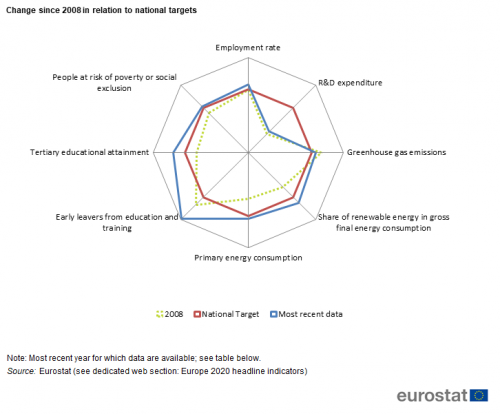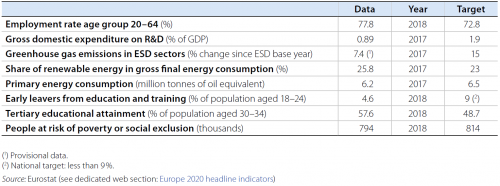Archive:Europe 2020 indicators - Lithuania
Data extracted in June 2019. Planned article update: September 2020.

Source: Eurostat (see dedicated web section: Europe 2020 headline indicators)
Explanations on this radar chart are available here.
This article is part of a set of statistical articles on Europe 2020 strategy, focusing on the situation in Lithuania.
Full article
Overview
In 2018, Lithuania had the highest share of 30- to 34-year-olds with tertiary education in the EU (57.6 %) and exceeded its national target by 8.9 percentage points. Additionally, the share of early leavers from education and training was half the EU total rate and well below the 9 % national target. Notable progress has also been made on climate change and energy. By 2017, the country had remained within its target to limit its ESD GHG emissions increases to 15 %. Lithuania had also exceeded its renewable energy and primary energy consumption targets by 2017. After a sharp drop in employment figures between 2008 and 2010, the rate climbed up again and in 2018 Lithuania surpassed its national 2020 goal by 5.0 percentage points. Between 2008 and 2018, the country lifted around 116 000 people out of the risk of poverty and social exclusion thus meeting its poverty-reduction target. In terms of R&D expenditure, a gap of one percentage point remains to be closed to reach the target of 1.9 % of GDP.

Source: Eurostat (see dedicated web section: Europe 2020 headline indicators)
Data sources
More information about the origin of the data and the calculation of indicators can be obtained via the Europe 2020 indicators dedicated website.
Under 'Main tables', click on the icons next to the indicators:
- 'Explanatory texts (metadata)' for a detailed overview of the collection and compilation methods;
- 'Information on the leaf' for data availability per country.
A more general overview of quality procedures can be found in Implementation of standard reference metadata for indicators - the ESMS Indicator Profile (ESMS-IP) (PDF file).
Context
Europe 2020 is the EU’s agenda for jobs and growth for the current decade. It emphasises smart, sustainable and inclusive growth as a way to strengthen the EU economy and prepare its structure for the challenges of the next decade. As a main objective, the strategy strives to deliver high levels of employment, productivity and social cohesion in the Member States, while reducing the impact on the natural environment.
Direct access to
- Smarter, greener, more inclusive - indicators to support the Europe 2020 strategy - 2019 edition (online publication, also downloadable as PDF file
- Towards robust quality management for European Statistics - Communication from the Commission to the European Parliament and the Council COM(2011) 211 final.
- Regulation (EC) No 223/2009 of 11 March 2009 on European statistics